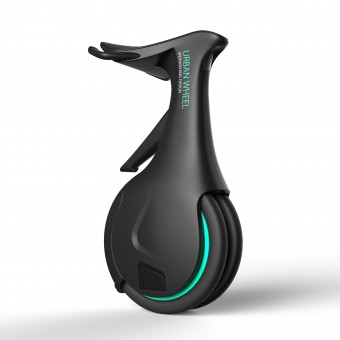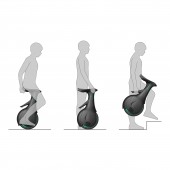Urban Wheel Electric Unicycle by Weinan Yang |
Home > Winners > #57454 |
 |
|
||||
| DESIGN DETAILS | |||||
| DESIGN NAME: Urban Wheel PRIMARY FUNCTION: Electric Unicycle INSPIRATION: Observing the existing self-balancing vehicles, such as unicycle, scooter, hover board and etc., I found an opportunity of bringing the enjoyment of self-balancing technology into our daily life in an easier, safer and handier way. The form design of Urban Wheel was inspired by the form language from Porsche, so as to achieve intimate connection with users and speedy aesthetics in one compact design. UNIQUE PROPERTIES / PROJECT DESCRIPTION: Urban Wheel is a redesign of electric unicycle, changing the way that users interact with it, to produce maximum value of self-balancing technology. Unlike the existing electric unicycles, Urban Wheel is used in sitting posture, which enables users to put their feet on the ground anytime needed, therefore making it easier to learn and safer to ride. With the compact and ergonomic form design, Urban Wheel maintains the advantage of portability as well. OPERATION / FLOW / INTERACTION: When riding Urban Wheel, users will have their hands resting on the rear handles, which gives them a good balance on fore and back sides of the center of gravity and allows them to push forward and backward easily. PROJECT DURATION AND LOCATION: The project started in January 2015 and finished in May 2015 in Hangzhou, and was exhibited in Zhejiang University in June 2015. |
PRODUCTION / REALIZATION TECHNOLOGY: Self-balancing technology, injection molded plastic housing, leather seat, aluminum alloy foot rest SPECIFICATIONS / TECHNICAL PROPERTIES: Product dimension: 292mm x 372mm x 713mm, wheel dimension: 118mm x 356mm x 356mm, battery dimension: 55mm x 90mm x 190mm, controller dimension: 55mm x 90mm x 190mm TAGS: Self-balancing, Electric unicycle, Bi-wheel, Transporter RESEARCH ABSTRACT: Using the existing products of Airwheel X3 and Airwheel Q3, I was able to build functional prototypes at the early ideation stage and test the feasibility of a concept in a fast and cheap way. I used plywood and steel tubes to build taller housing and adjustable handles upon the Airwheel X3 model, and then had some schoolfellows and myself try to ride the prototype. I found that it was a lot easier to learn and safer to ride when users are able to sit on the unicycle, since it allowed them to put their feet on the ground to help balance in learning stage and to brake the device for emergency purpose. And I also found that putting the handles in front resulted difficulty to brake the unicycle quickly, because both legs and arms were placed in front of the users, which made it inactive to push force on the back side. So I moved the handles to the rear, achieving a good sensitivity of driving forward and braking. Furthermore, I switched from Airwheel X3 to Airwheel Q3 which was a bi-wheel unicycle, so as to diminish the difficulty of the balance on left-right axis. This research process generated most of the physical and technical constrains that I carried through next stage of form design. CHALLENGE: Due to the instability feature of unicycle, the main challenge was to find a posture in which users could balance stably on it and control it flexibly at the same time. It was difficult to understand and judge which posture was better than which, because there were many factors affecting the experience, including sitting center, seat height, handle height and user height. I went through lots of adjustments of position and proportion in the functional prototypes, to finally approach to a chosen posture. ADDED DATE: 2017-04-04 06:24:52 TEAM MEMBERS (1) : Weinan Yang IMAGE CREDITS: Weinan Yang, 2015 |
||||
| Visit the following page to learn more: http://yangdesign.org/ | |||||
| AWARD DETAILS | |
 |
Urban Wheel Electric Unicycle by Weinan Yang is Winner in Vehicle, Mobility and Transportation Design Category, 2016 - 2017.· Press Members: Login or Register to request an exclusive interview with Weinan Yang. · Click here to register inorder to view the profile and other works by Weinan Yang. |
| SOCIAL |
| + Add to Likes / Favorites | Send to My Email | Comment | Testimonials | View Press-Release | Press Kit |







